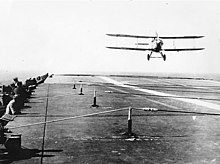Fairey III
| Fairey III | |
|---|---|
 Fairey III-F aboard the British aircraft carrier HMS Furious ; around 1930 |
|
| Type: | double decker |
| Design country: | |
| Manufacturer: | |
| First flight: |
September 14, 1917 |
The Fairey III was a British double-decker that was produced by Fairey Aviation from 1917 . It was used both as a seaplane and an aircraft carrier-based aircraft and was one of the aircraft types in the Royal Air Force and Royal Naval Air Service . The service time extended from 1917 until well into the Second World War, making it one of the longest-running aircraft in the British Army.
history
The prototype of the Fairey III, designated N.10, was a seaplane for the Royal Naval Air Service. The first flight took place on September 14, 1917.
The first models were the IIIA and the IIIB , of which 50 and 30 machines were built. In the First World War , however, the machines were hardly used. The IIIC was followed by a bomber version, of which 36 were produced. A small number were used in the Russian Civil War in Arkhangelsk in 1919.
With the IIID , mass production began in 1921; a total of 226 machines of this type were built. They were exported to Portugal and Australia.
Most Fairey III had water-cooled 12-cylinder Napier Lion engines, but there were also types with 375 hp (280 kW) Rolls-Royce Eagle VII engines.
The seaplanes were usually launched by catapult launch and later landed in front of the carrier ship to be hoisted on board.
The most successful type was the model IIIF , which was used in Egypt by the Royal Air Force from 1927 . The New Zealand Royal New Zealand Air Force also used these machines. Over 300 IIIFs operated in the FAA ( Fleet Air Arm ) between the world wars . Only the Hawker Hart achieved higher production numbers than the Fairey III.
Carrier -based IIIFs were used on the aircraft carrier HMS Furious .
Three radio-controlled IIIFs were used for air defense training and are therefore considered to be historical pioneers of unmanned aviation . Until 1941 they served as target drones and training targets for fighter pilots in the Royal Air Force. The Fairey III formed the basis or the predecessor of the Fairey Gordon and Fairey Seal types .
A copy is now in Portugal in the Museu da Marinha (Naval Museum) in Lisbon .
Versions
- Fairey N.10
- Fairey IIIA
- Fairey IIIB
- Fairey IIIC
- Fairey IIID
-
Fairey IIIF
- Fairey IIIF I
- Fairey IIIF II
- Fairey IIIF III
- Fairey IIIF IV
Technical data (Fairey IIIF IV)
| Parameter | Data |
|---|---|
| crew | 2 |
| length | 11.20 m |
| span | 13.95 m |
| height | 4.32 m |
| Wing area | 41 m² |
| Empty mass | 1764 kg |
| Max. Takeoff mass | 2746 kg |
| Cruising speed | ? km / h or kts |
| Top speed | 192 km / h |
| Service ceiling | 6098 m |
| Max. Climb performance | 254 m / min |
| Range | 2432 km |
| Engines | 1 × Napier Lion XI, 570 PS (419 kW ) |
| Armament | 1 × 303 Vickers machine gun, 1 × 303 Lewis machine gun, bombs could be carried under the wings |
literature
- A. Lumsden, T. Heffernan: Per mar probare (Part 6) - Fairey IIIF. Airplane Monthly, September 1987
